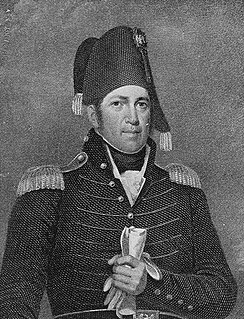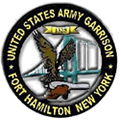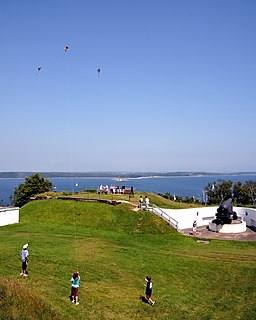This page is based on this
Wikipedia article Text is available under the
CC BY-SA 4.0 license; additional terms may apply.
Images, videos and audio are available under their respective licenses.

Fort Schuyler is a preserved 19th century fortification in the New York City borough of the Bronx. It houses a museum, the Stephen B. Luce Library, and the Marine Transportation Department and Administrative offices of the State University of New York Maritime College. It is considered one of the finest examples of early 19th century fortifications. The fort was named in honor of Major General Philip Schuyler of the Continental Army.

The first USS Oneida was a brig of war in the United States Navy during the War of 1812.

Jacob Jennings Brown was an American army officer in the War of 1812. His successes on the northern border during that war made him a hero. In 1821, he was appointed Commanding General of the United States Army and held that post until his death.
USS Julia was a schooner in the United States Navy during the War of 1812.

Fort Hamilton is a United States Army installation in the southwestern corner of the New York City borough of Brooklyn, surrounded by the communities of Bay Ridge and Dyker Heights. It is one of several posts that are part of the region which is headquartered by the Military District of Washington. Its mission is to provide the New York metropolitan area with military installation support for the Army National Guard and the United States Army Reserve. The original fort was completed in 1831, with major additions made in the 1870s and 1900s. However, all defenses except about half of the original fort have been demolished or buried.

The Second Battle of Sacket's Harbor or simply the Battle of Sacket's Harbor, took place on 29 May 1813, during the War of 1812. A British force was transported across Lake Ontario and attempted to capture the town, which was the principal dockyard and base for the American naval squadron on the lake. Twelve warships were built here. The British were repulsed by American regulars, militia, marines and sailors.

The Capture of Fort Niagara took place late in 1813, during the War of 1812 between the United Kingdom and the United States. The American garrison was taken by surprise, and the fort was captured in a night assault by a select force of British regular infantry.

The First Battle of Sacket's Harbor was a battle fought on July 19, 1812, between the United States and the British Empire; it was the first engagement of the war between these forces. It resulted in American forces repelling the attack on the village and its important shipbuilding yard, where 12 warships were built for this war.
The Carthage, Watertown and Sackets Harbor Railroad opened in 1875. It was built within the village of Sackets Harbor on the railbed of the former Sackets Harbor and Ellisburg Railroad. Incorporated into the New York Central Railroad in 1893. It ceased operating in 1949. It went from Sackets Harbor eastward to join the Rome, Watertown and Ogdensburg Railroad at Watertown.

York Redoubt is a redoubt situated on a bluff overlooking the entrance to Halifax Harbour at Ferguson's Cove, Nova Scotia, Canada, originally constructed in 1793. It was designated a National Historic Site of Canada in 1962.

Sackets Harbor Battlefield State Historic Site is a historically important location in Jefferson County, New York, United States. The historic site is south of the Village of Sackets Harbor, bordering Lake Ontario in the Town of Hounsfield. Two battles were fought near this location during the War of 1812. Some 3,000 men worked at the shipyard building warships, and the village was fortified and garrisoned with thousands of troops.

The Engagements on Lake Ontario encompass the prolonged naval contest for control of the lake during the War of 1812. Few actions were fought, none of which had decisive results. The contest essentially became a naval building race, sometimes referred to sarcastically as the "Battle of the Carpenters."
Fort Tompkins may refer to any of several War of 1812 forts named for Governor Daniel D. Tompkins of New York State:
William Donnison Ford, was an American lawyer and politician from New York.
USS Madison was a U.S. Navy corvette built during the War of 1812 for use on the Great Lakes.

Ichabod Bennet Crane was a career military officer for 48 years and the probable namesake of the protagonist in Washington Irving's The Legend of Sleepy Hollow.

Fort Stark is a former military fortification in New Castle, New Hampshire, United States. Located at Jerry's Point on the southeastern tip of New Castle Island, most of the surviving fort was developed in the early 20th century, following the Spanish–American War, although there were several earlier fortifications on the site, portions of which survive. The fort was named for John Stark, a New Hampshire officer who distinguished himself at the Battle of Bennington in the American Revolution. The purpose of Fort Stark was to defend the harbor of nearby Portsmouth and the Portsmouth Naval Shipyard. The fort remained in active use through the Second World War, after which it was used for reserve training by the US Navy. The property was partially turned over to the state of New Hampshire in 1979, which established Fort Stark Historic Site, and the remainder of the property was turned over in 1983. The grounds are open to the public during daylight hours.












